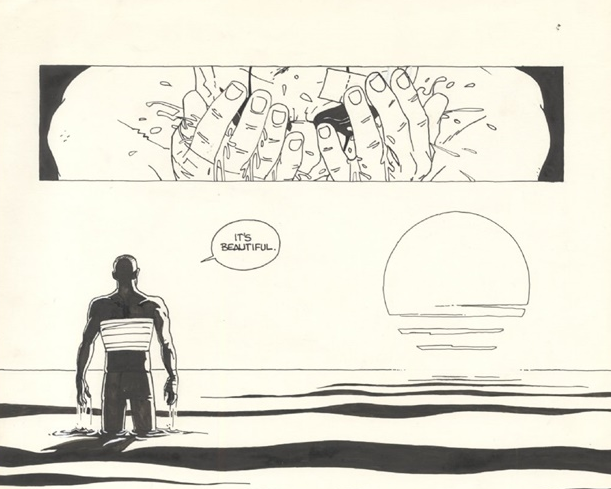300's new sequel series (or is it a prequel?) Xerxes: The Fall of the House of Darius and the Rise of Alexander #1 (henceforth referred to here just as Xerxes #1) is the work of a seasoned professional who knows all of the visual shortcuts to use without it ever feeling like he’s skimping on the work. Centered on two battles between the ancient Athenians and Persians, Miller’s story focuses on the strategies of war circa 490 B.C. when war was up close and fought with spears and swords. The nobility and skills of the Athenians are on display, as is their pride. Only three characters really get explored in this story; the captain Themistokles, the warrior Aeskylos, and the strategist Miltiades (a “fop” according to Themistokles.). Their enemies, the Persians and the Ethiopians, are nameless as they are merely armies and not people in Miller’s story.
While things like “justice” and “honor” may be implied in the apparent heroism of the Athenians, the questions of why this war and what is it about remain largely unanswered until the very end. Xerxes #1 is a war comic as Themistokles, Aeskylos and their own largely faceless armies hack at their enemies. The war is the story of this first issue but not the reasons for war. As Miller draws these very different armies, either the fully clothed Persians and Ethiopians or the loinclothed and helmeted Athenians, there’s very little else other than their appearances to tell them apart. At this stage of the war, there is no right and wrong, no good and evil; there is just the us-versus-them that’s part of every battle in history.
The important thing to remember is that this is not the Frank Miller of 1983, 1986, 1996 or even 2011. The artwork in Xerxes #1 is by a Miller who has the time and inclination to lay down only the marks that advance his story. From the nearly identically detailed uniforms of the Persians to the repeated battle formations of the Athenians, Miller creates with pen and brush the repetition that other artists would use Photoshop for, creating a sense of uniformity and even steadiness in these forces without every reducing them to being just another body. Sure they may not get names or even faces, but the skill spent in drawing and defining them establishes them men and soldiers on the battlefield.
The recent reunion of Miller and Klaus Janson on DC’s Dark Knight III: The Master Race demonstrated just how far apart these once totally in sync collaborators have grown apart. If anything, Janson’s inks over Miller took a necessary edge off of Miller’s artwork. There was a polish to it but it lacked the precision of tone that Janson so perfectly complemented in those older comics. On his own in this comic, Miller’s final inked marks are terse and taut, being as minimalistic or as haphazard and chaotic as required. It’s still exciting to see Miller drawing comics because he has been an artist that’s never been satisfied with finding a style and sticking to it. While his art is almost instantly recognizable, he is an artist that lets his story define how he’s going to tell it rather than trying to fit a story into an established and commoditized formula.
It’s fascinating to see how Miller uses patterns and repetition in this comic, mostly when drawing the armies. As much as it’s just easy to tell the sides apart thanks to the repeating visual motifs, it also creates the sense of the size of these armies. Except for a few really large spreads, there are few pages or panels that are just filled with Geoff Darrow levels of characters or details. But the use of the repeated poses creates the sense of large numbers of soldiers fighting. But it also generates this amazing sense of movement and clashing in these pages. One page features just three horizontal panels of characters lined up side by side or single file but the way that Miller knows that we’ll read these figures from left to right captures movement, time and momentum in these images.
Sadly missing this time around is Lynn Varley. Instead of Varley, Alex Sinclair colors Miller’s work here. Far more a traditionalist than Varley ever was, Sinclair’s colors at best don’t get in the way of Miller’s artwork and, at their worst, feel overwrought and emotionally flat. The handmade tone of Miller’s rough-hewn artwork and traditional hand-lettering is undone by computerized and colors that rarely has the same organic feel as the rest of the issue does. It’s highfalutin to say that Sinclair colors Frank Miller’s work while Varley paints it but that’s the difference in this series from Miller’s earlier comics.
Xerxes: The Fall of Darius and the Rise of Alexander #1 is from a different Frank Miller than the one who did 300, Ronin, Sin City or The Dark Knight Returns. Building on the lessons of all of those earlier works, Miller has found a way to simplify this artwork while trying to wring as much narrative momentum out of it. While it may be a bit early to declare this a classic or that Frank Miller’s back! (whatever that may mean,) Xerxes #1 is a confident comic that shows that Miller may still have something to prove to himself and his readers.
Xerxes: The Fall of Darius and the Rise of Alexander #1
Written and Drawn by Frank Miller
Colored by Alex Sinclair












